

The Sky Tonight - Astronomy News UK, Night Sky, Celestial Events, Images, Books and Star Naming Service. Northern Hemisphere.
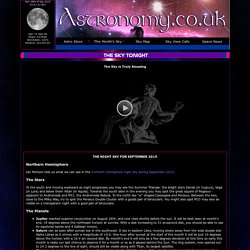
'Diamond rain' falls on Saturn and Jupiter. 14 October 2013Last updated at 07:04 ET By James Morgan Science reporter, BBC News Diamond rain could be "the most common precipitation in the Solar System" the authors say Diamonds big enough to be worn by Hollywood film stars could be raining down on Saturn and Jupiter, US scientists have calculated.
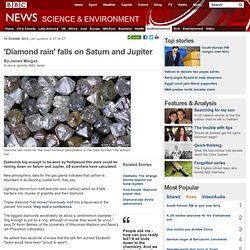
New atmospheric data for the gas giants indicates that carbon is abundant in its dazzling crystal form, they say. Lightning storms turn methane into soot (carbon) which as it falls hardens into chunks of graphite and then diamond. These diamond "hail stones" eventually melt into a liquid sea in the planets' hot cores, they told a conference. Curiosity rover's methane result challenges life theory. 19 September 2013Last updated at 14:01 ET By Jonathan Amos Science correspondent, BBC News The Tuneable Laser spectrometer sits inside the body of the rover The Curiosity rover's failure to detect methane on Mars is a blow to theories that the planet may still host some types of life, say mission scientists.
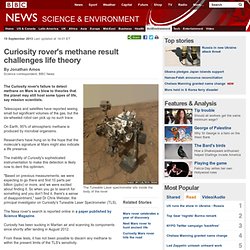
Telescopes and satellites have reported seeing small but significant volumes of the gas, but the six-wheeled robot can pick up no such trace. On Earth, 95% of atmospheric methane is produced by microbial organisms. Researchers have hung on to the hope that the molecule's signature at Mars might also indicate a life presence. The inability of Curiosity's sophisticated instrumentation to make this detection is likely now to dent this optimism. "Based on previous measurements, we were expecting to go there and find 10 parts per billion (ppbv) or more, and we were excited about finding it.
Science & Environment - How to defend Earth from asteroids. Synopsis What's six miles wide and can end civilization in an instant?
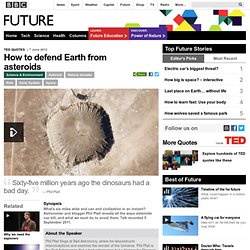
Astronomer and blogger Phil Plait reveals all the ways asteroids can kill, and what we must do to avoid them. Talk recorded 5 September 2011. Does gold come from outer space? 18 September 2013Last updated at 21:26 ET By William Kremer BBC World Service The idea that gold came from outer space sounds like science fiction, but it has become well-established - it's pretty much received opinion in the field of earth sciences.
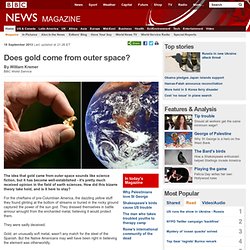
How did this bizarre theory take hold, and is it here to stay? Voyager probe 'leaves Solar System' 12 September 2013Last updated at 14:00 ET By Jonathan Amos Science correspondent, BBC News Voyager will live out its days circling the centre of our Milky Way Galaxy The Voyager-1 spacecraft has become the first manmade object to leave the Solar System.
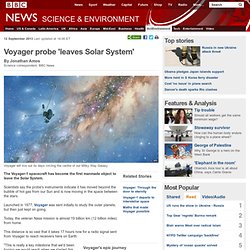
Scientists say the probe's instruments indicate it has moved beyond the bubble of hot gas from our Sun and is now moving in the space between the stars. Launched in 1977, Voyager was sent initially to study the outer planets, but then just kept on going. Today, the veteran Nasa mission is almost 19 billion km (12 billion miles) from home. This distance is so vast that it takes 17 hours now for a radio signal sent from Voyager to reach receivers here on Earth.
"This is really a key milestone that we'd been hoping we would reach when we started this project over 40 years ago - that we would get a spacecraft into interstellar space," said Prof Ed Stone, the chief scientist on the venture. Project scientist Prof Ed Stone: "We got there! " Earth life 'may have come from Mars' 28 August 2013Last updated at 20:09 ET By Simon Redfern Reporter, BBC News, Florence Life would face challenges on Mars today, but billions of years ago conditions might have been better Life may have started on Mars before arriving on Earth, a major scientific conference has heard.

New research supports an idea that the Red Planet was a better place to kick-start biology billions of years ago than the early Earth was. The evidence is based on how the first molecules necessary for life were assembled. NASA taste-tests Mars menu (tip: avoid the Kung-fu chicken) - Technology & Science. A Canadian who spent four months living in a simulated Mars habitat as part of a NASA-funded project to test food that people might eat on Mars says it has changed his perspective on Spam.
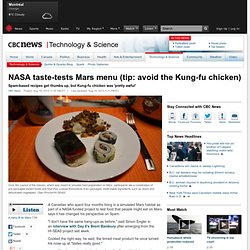
Science & Environment - How to predict the end of the universe. How can we gauge the age of the Universe – and when it might end?
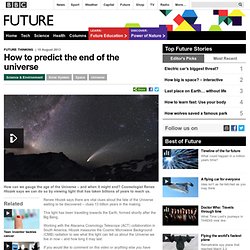
Cosmologist Renee Hlozek says we can do so by viewing light that has taken billions of years to reach us. Renee Hlozek says there are vital clues about the fate of the Universe waiting to be discovered – clues 13 billion years in the making. This light has been travelling towards the Earth, formed shortly after the Big Bang. Working with the Atacama Cosmology Telescope (ACT) collaboration in South America, Hlozek measures the Cosmic Microwave Background (CMB) radiation to see what this light can tell us about the Universe we live in now – and how long it may last. Meteor shower calendar - Technology & Science. Stargazers get multiple chances each year to see meteor showers — celestial shows in which an unusual number of shooting stars streak across the night sky.
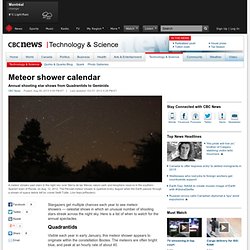
Here is a list of when to watch for the annual spectacles. Quadrantids Visible each year in early January, this meteor shower appears to originate within the constellation Bootes. The meteors are often bright blue, and peak at an hourly rate of about 40. Lyrids This shower begins every year in mid-April. Technology - Can we build a lift that could take us into space? Rockets are an expensive way of taking people to the final frontier, so James May finds out whether the concept of an elevator could ever get off the ground. Space is the final frontier. Or is it? Could we not think of it perhaps as the 4,000th floor instead? James May looks at why we need alternatives to rockets, and the physics and practicalities behind constructing a space lift. Gravity controls icy moon Enceladus's spew. 31 July 2013Last updated at 14:26 ET By Melissa Hogenboom Science reporter, BBC News Fountains of water ice are blasted thousands of kilometres above the surface of Saturn's tiny moon Enceladus Saturn's gravitational pull is responsible for the extraordinary hot geysers on the Enceladus moon that spew water out into space.
- StumbleUpon. Nasa's Hubble telescope discovers new Neptune moon. 15 July 2013Last updated at 19:30 ET Voyager failed to spot the tiny moon during its 1989 fly-pass The Hubble space telescope has discovered a new moon orbiting Neptune, Nasa has confirmed. Speedy tsunami seen on Sun's surface. 17 July 2013Last updated at 12:27 ET By Jason Palmer Science and technology reporter, BBC News. Glass rain may give planet blue hue. 11 July 2013Last updated at 11:23 ET The turbulent alien world - seen in this artist's impression - lies some 63 light-years from Earth For the first time, astronomers have determined the true colour of a planet orbiting another star.
The world, known as HD189733b, has a deep azure hue - probably the result of silicate (glass) rain in the atmosphere, which scatters blue light. Details of the discovery, made with the Hubble Space Telescope, are to appear in Astrophysical Journal Letters. Although it might resemble Earth from a distance, HD189733b is a huge gas giant which orbits close to its host star. The temperature of the planet's atmosphere is a scorching 1,000C, and it rains glass, sideways, in howling 7,000km-per-hour winds. Its atmosphere has been found to be dramatically changeable and exotic, with hazes and violent bursts of evaporation.
Nasa’s Cassini probe to acquire distant Earth portrait. Met Lovejoy flies into Sun to reveal solar secrets. Worlds: The Kepler Planet Candidates. Sunjammer spacecraft to 'sail' towards the sun. Burn notice: NASA discovers that fireproof materials ignite in space. Still frames showing a piece of cotton-fiberglass, similar to the cotton civilian clothing worn by astronauts, burning from bottom-to-top during a space station experiment (Credit: Paul Ferkul/NASA/BASS). Science & Environment - Nasa Ladee mission: Solving a Moon mystery. Nasa's Ladee mission is part of a resurgence of interest in the Moon and it is all down to the fact that we barely understand our cosmic neighbour. You would be forgiven for thinking that America lost interest in the Moon forty years ago, in December 1972, when Apollo 17 astronaut Gene Cernan left the final footprint on its dusty surface.
It’s certainly true that in the 1970s and 80s there was little desire to return to our grey, cratered cosmic neighbour. In fact during the 1980s no-one sent a single spacecraft, robot or orbiter. Thanks to Apollo, American scientists had an enormous pile of lunar rocks to study, Nasa’s attention had switched to the Space Shuttle and the Soviets had run out of money. But in recent years, there has been a resurgence of interest in studying the Moon in order to tackle some of the many unanswered scientific questions. Science & Environment - Driving Mars Rovers: ‘It can get a little boring’ Nasa driver who has clocked up most miles on the Red Planet reveals what it’s really like to be behind the wheel of a space rover. I met a man employed on Mars. Not just watching it from a distance, but doing things on its surface. First glimpse of a black hole's spin.
Astronomers have measured the rate of spin of a supermassive black hole for the first time - and it is big. Measurements undertaken with two space-based X-ray telescopes imaged the black hole at the centre of galaxy NGC 1365. The spin measurement, published in Nature, gives precious clues as to how the black hole grew and achieved supermassive status. That growth influences the evolution of galaxies, so this simple number stands to teach scientists a great deal. Black holes are notoriously difficult to study, since so much in astronomy depends on the detection of light - and within a certain distance from a black hole, even that cannot escape. Planck satellite: Maps detail Universe's ancient light. By Jonathan Amos Science correspondent, BBC News, Paris.
Meteors, Comets & Asteroids. 3D printed moon building designs revealed. 1 February 2013Last updated at 12:21 GMT. Planet with four suns discovered. 15 October 2012Last updated at 11:33 ET By Paul Rincon Science editor, BBC News website. Astronomy Photographer of the Year 2012. 20 September 2012Last updated at 05:59 ET. The Montréal Planetarium — What's Up — Celestial Events. The Montréal Planetarium — What's Up — Celestial Events. Nasa announces space shuttle replacement shortlist. Helix Nebula. Child's toy launched into space by students. Skydiver Felix Baumgartner breaks sound barrier.